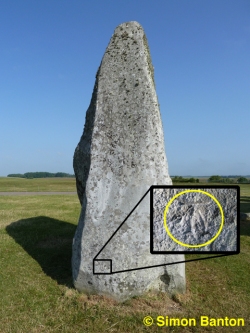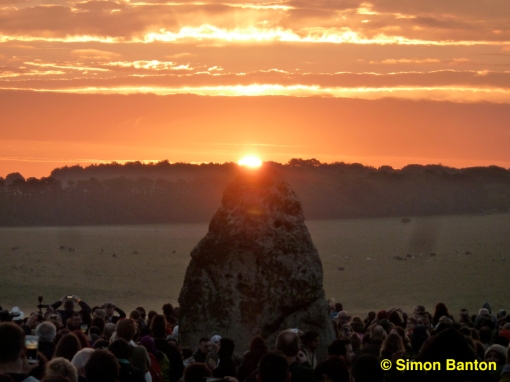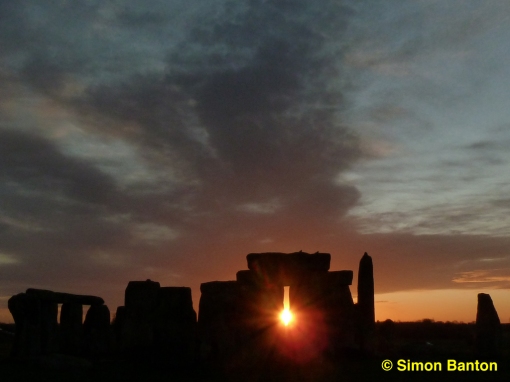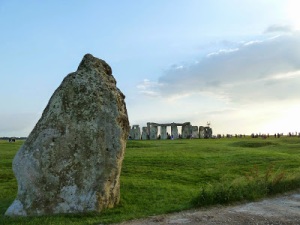Amongst all the various carvings on the stones at Stonehenge, from the modern graffiti of the 17th to the 20th century and the ancient axe heads and daggers from about 1700BC, there are three that are not often noticed.
These are the Ordnance Survey (OS) benchmarks.
The OS website says: “Bench marks are the visible manifestation of Ordnance Datum Newlyn (ODN), which is the national height system for mainland Great Britain and forms the reference frame for heights above mean sea level.”
The original reference datum levelling survey was begun in Liverpool in 1840 using a benchmark on St. John’s Church, and in 1844 it was changed to the tidal pole in Victoria Dock. The reference Mean Sea Level (MSL) for the datum was established over a nine day period of tidal observations.
A second levelling survey was carried out in 1912-21 and the datum was changed to MSL at Newlyn in Cornwall. In the 1950s a third survey was performed, still making use of the Newlyn datum.
The OS benchmarks at Stonehenge are in the traditional form of three lines / | \ beneath a horizontal bar which is the indicator of the reference height above the datum’s MSL at that spot.
 Coincidentally, this is a similar form to that of the Druidic “Awen” emblem which also uses three lines / | \ but positioned below three dots rather than a horizontal bar. See https://en.wikipedia.org/wiki/Awen for the history and an explanation of this symbol.
Coincidentally, this is a similar form to that of the Druidic “Awen” emblem which also uses three lines / | \ but positioned below three dots rather than a horizontal bar. See https://en.wikipedia.org/wiki/Awen for the history and an explanation of this symbol.
At Stonehenge two of the benchmarks are on the Heel Stone and one is on Stone 16.
Stone 16 is the tooth-like stone at the southwest side of the monument directly behind the tallest stone on the site, and the benchmark is low down on the left of the southeast face.
This references the Newlyn datum, is 103.114m above MSL and was last verified in 1957.
The Heel Stone is the massive leaning stone some 80m northeast of the stone circle which famously (but only roughly) indicates the position where the sun appears on the horizon at the summer solstice as seen from the centre of the stone circle.
Its benchmarks are low down on the right hand side of the northeast face
The upper one references the original Liverpool datum, is 101.346m above MSL and was last verified in 1900.
The lower one references the Newlyn datum, is 100.7m above MSL and was last verified in 1957.
From the Newlyn benchmarks, you can work out that there’s a drop of 2.414m from the one on Stone 16 to the one on the Heel Stone.
None of these benchmarks are visible from any of the visitor paths around the monument, although if the light is right (early morning or evening in summer) the upper one on the Heel Stone can just be made out from the National Trust field.
To see them properly you’ll need to come to one of the Managed Open Accesses at the solstices or equinoxes.
Alternatively, you can book a private Stone Circle Access visit which take place most days of the year before and after regular opening times.
STONE CIRCLE ACCESS
Stone Circle Access visits, give you a unique opportunity to experience up close this world famous monument. The visits take place outside of our normal general admission opening hours and are subject to very limited availability. Please note that this is not a guided tour, and touching of the stones is not permitted. You can try Stonehenge Guided Tours for these special access tours
Article by guest blogger and local Stonehenge historian Simon Banton
The Stonehenge News Blog
Follow us on Twitter and Facebook for all the latest Stonehenge news and discoveries
 witness the most famous of these – the Summer Solstice Sunrise on June 21st.
witness the most famous of these – the Summer Solstice Sunrise on June 21st.

















